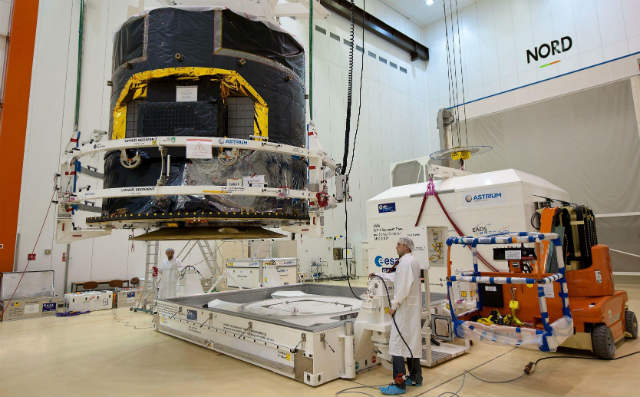Europe looks to be on the cusp of taking a dramatic step forward in its ability to oversee military operations from space, as Airbus Defence & Space readies satellite technology capable of streaming real-time video from geostationary orbit.
The system, outlined on 8 October at a Royal Aeronautical Society conference in London on space strategy, would be built around a 4m (13ft) mirror developed from the optics that Airbus built for the European Space Agency’s galaxy-mapping Gaia spacecraft.

Rex Features
This so-called GO-3S – for Geostationary Space Surveillance System – will be capable of returning video at a rate of up to five images per second at 2.5-3m resolution. In geostationary orbit at 36,000km (22,400 miles), one such satellite could view a quarter of the globe – an area roughly the size of Asia – and its camera could be pointed within 5min, for virtually immediate video imaging of a battlefield, disaster site or other point of interest. Two spacecraft would cover half of the planet.
As a sample of the sort of video that can be expected from GO-3S, retired French air force general Jean-Pierre Serra – who is now a special adviser to Airbus Defence & Space chief executive Bernhard Gerwert – showed real-time images of a fighter aircraft strike, of aircraft moving on a runway and of ships approaching a harbour.
The advantage over a similar concept that would work from low Earth orbit (LEO), some 800km up as a development of Airbus’s Pléiades observation satellites is in time, Serra says. Higher resolution is possible from LEO, but it could take anywhere up to half a day to direct the satellite, and then it could only provide images for a few minutes while it passes overhead.
For now, Serra says, GO-3S is being developed around camera imagery. But with operational experience, a “phase two” system should also incorporate infrared, for 24h operation.
Airbus has self-funded development for four years and now needs a customer’s backing to orbit a functioning system, which he says is possible by 2020 or 2021 at the latest.
Speaking broadly about Europe’s military space capability, Serra told the RAeS that, today, no European space programme is purely civil or purely military.
The use of Gaia technology is a case in point. That spacecraft, launched in December 2013 and now scanning 1 billion stars and other objects in the Milky Way in unprecedented detail from a stable point in space 1.5 million kilometres from Earth, is built around the most sophisticated – and geometrically stable – mirrors ever flown in space.
Source: FlightGlobal.com



















